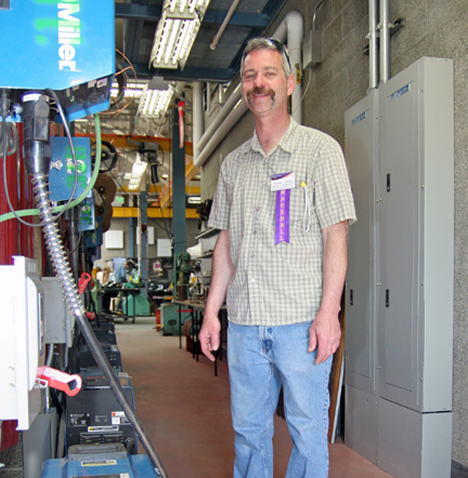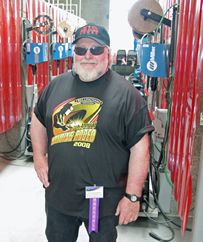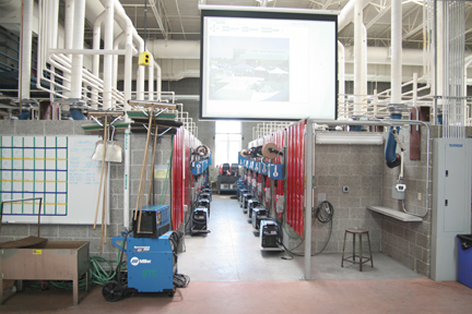It may surprise manufacturers, fabricators, technical institutions and other large users of welding equipment to learn that their public utility is less interested in sending monthly billing statements than it is in providing energy as effectively as possible, creating benefits for customers, the community and the utility.
“Increasing energy efficiency is one of the best investments we can make to help meet the growing demand for electricity and natural gas in the region,” says Rebekah Anderson, Program Manager, Corporate Communications for Puget Sound Energy (PSE, Bellevue, Wash.). “PSE encourages all of its customers to be efficient in their use of energy. We have a broad array of programs, financial incentives (grants and rebates), and tools designed to offer all of our customers the opportunity to participate in conserving energy.”
In a collaboration involving PSE and Bellingham Technical College (BTC, Bellingham, Wash.), PSE demonstrated its dedication to smart energy management by granting BTC a $1,000 per welder financial incentive. The college would use the money to help offset the costs of 26 advanced, inverter-based welding power sources from Miller Electric Mfg. Co.
The welders, no
w installed in BTC’s new 20,000-sq.-ft. welding and fabrication facility, include a mixture of XMT® 304 and XMT 350 CC/CV multiprocess welders (Stick, TIG, MIG, flux cored and carbon arc gouging) and Maxstar® 200 DC TIG/Stick welders. The new welders draw one-third to one-sixth less amperage and reduce utility bills by an estimated $200 per year per welder.
 |
| “Since installing our new inverters, we’ve never had the circuit breaker trip,” says Russell Jones, Welding Technology Instructor, Bellingham Technical College. Previously, the college’s old, amperage-hungry welders caused nuisance trips that disrupted almost every class. |
Energy-sucking “Cave”
“Our previous facility is affectionately called ‘the cave.’ We had 30 welding units in a 4,000-sq.-ft. area with a 10-ft. ceiling, low lighting conditions, and poor ventilation,” says Don Anderson, one of four Welding Technology Instructors at BTC. “We were using two-decade old, power-sucking transformer rectifier units, and they caused the breakers to trip constantly. Then, at one point, transformers on the old welders started blowing and machines started dying en masse.”
In addition to reliability issues of old Stick/TIG equipment, Welding Technology Instructor Jere´ Donnelly notes that, “Local industry, notably shipbuilders and oil refineries, increased their need for welders trained on wire feed processes, so we needed to upgrade our equipment to keep pace with technology and the demand for skilled welders.”
BTC’s Welding Technology program prepares students for employment in the metal and construction trades. They gain experiences and competencies in all major welding theories, processes and Washington Association of Building Officials (WABO) welding certification testing procedures. Students can earn a certificate or Associate of Applied Science (AAS) degree in Welding with a specialization in Structural Steel Fabrication, Pipe Welding & Fitting, or Aluminum.
To better prepare its students, BTC began, in 2004, planning for a its new welding and fabrication shop, which would in turn be part of a new building dedicated to the school’s Manufacturing and Industrial Technology program. While the new facility would not be ready until the fall semester of 2007, plans to acquire new welding equipment moved more quickly.
 |
| Don Anderson, a Welding Technology Instructor at Bellingham Technical College with nearly 30 years of welding experience, notes that the enhanced arc characteristics of inverters help beginners learn to weld more quickly. |
BTC’s Donnelly and Anderson contacted Marshall Judy, the sales manager for Central Welding Supply (Bellingham, Wash.) to discuss welding fleet replacement stragegies. Judy, now also a BTC Welding Program Advisory board member, knew the appropriate contact at PSE and was familiar with its custom grant programs.
PSE has an entire division dedicated to energy efficiency, as well as a dedicated portion of its Web site (home page: www.pse.com). While PSE’s Web site lists lighting, HVAC, adjustable speed drives and water heating as some of the equipment eligible for incentives, it does not specifically describe programs for welding equipment. However, because welders consume huge amounts of power, utilities such as PSE can often create custom programs.
“Any undertaking that helps a business reduce energy consumption is worth exploring,” says PSE’s Anderson. “Industrial companies should contact their utility and see what types of programs are already in place. By starting a dialog with their utility company representative, they may find that there are other opportunities on which they can collaborate.”
Anderson emphasizes that utilities have a strong incentive to reduce energy use. “As the population grows and energy demand grows, there’s only a finite amount of infrastructure in place to meet increasing demand. It’s a win-win situation for PSE and its customers to reduce energy use, which is why we created financial incentives such as the grant program that helped BTC.”
As part of the equipment justification efforts, BTC’s Anderson calculated the primary amperage draw and power consumption of eight TIG/Stick and 18 multiprocess inverters. If all 26 units welded simultaneously at their rated output, total amperage draw would be less than 390 amps (see Fig. 1). In comparison, BTC’s old 30 units would draw a combined 1,110 amps.
|
Welding Unit
|
Welding Output
|
Primary Amperage Required – 1 unit (460V, 3-phase)
|
Primary Amperage Draw
|
Welding Units per 1000-amp Service*
|
|
XMT 304
(300-amp multiprocess)
|
300 A/32V @ 60%
|
18.9 amps
|
18 units –
340 amps
|
52
|
|
XMT 350
(350-amp multiprocess)
|
350 A/34V @ 60%
|
17.8 amps
|
18 units –
320 amps
|
56
|
|
Maxstar 200
(200-amp TIG/Stick)
|
150 A/26V @ 60%
|
6.4 amps
|
8 units –
51 amps
|
156
|
|
BTC’s old Stick/TIG welders
|
400 A/36V @ 60%
|
37 amps
|
30 units –
1,110 amps
|
27
|
|
Fig. 1—Compared to conventional transformer-rectifier style DC Stick/TIG welders, modern inverters draw one-third to one-sixth the primary amperage. Note that while carbon arc gouging requires more amperage, most Stick welding is done at 150 amps or less.
* Each welder requires its own individual branch circuit, protected by a circuit breaker or fuse that is sized as specified by the welding machine manufacture.
|
As Fig. 2 shows (see “BTC Power Savings Calculation PDF”), BTC would save more than $5,000 per year in energy costs. With $5,000 per year in reduced energy costs, PSE would receive a payback on is $26,000 grant in five years.
BTC’s Anderson notes that, like most managers of large welding fleets, BTC had planned to replace its older welders a few units at a time, removing the most troublesome units first. However, he says, “We were able to give the college evidence of the inverter’s energy savings. We showed them how inverters would produce a return on their investment over a 10-year period, so they bought into the concept of replacing all of our welders at one time.”
Optimizing the Environment
BTC acquired its first 26 inverters in 2005, and the instructors noticed an immediate environmental improvement.
“Besides the energy bill going down, I notice that the noise and heat level went down considerably,” says Donnelly. “The heat produced by the old rectifiers caused their fans to run constantly. Further, inverters are so compact and portable that we can mount them up high or tuck them against the wall. The work area is cleaner and easier to work in, plus there are fewer tripping hazards.”
Russell Jones, another BTC Welding Technology Instructor, recalls that, “The circuit breakers used to trip all the time at our old building, and we’d have to call the electrician to reset them. Since installing inverters, we’ve never had the breaker trip.”
 |
| Bellingham Technical College received a $26,000 grant from Puget Sound Energy to help with the acquisition of 26 energy-efficient inverters. Now in the college’s new 20,000-sq.-ft. welding and fabrication facility (shown here), these inverters lower utility bills by an estimated $5,000 per year. |
Most importantly, BTC’s equipment now offered state-of-the-art performance. Inverters provide more control over arc starts and welding arc stability, as well as the ability to optimize arc performance for different types of Stick electrodes (e.g., E6010 or E7018). Inverters help students succeed faster when they’re learning to weld, giving them more confidence to pursue a welding career.
“As a technical college, its our mission to mirror industry demands and emulate their working conditions and standards,” says Donnelly. “By switching to inverters and all their advanced capabilities, BTC better meets the needs of the community and our students.”
Understanding Energy Efficiency
When it comes to energy, inverters provide two distinct, yet often confusing, advantages: good energy efficiency and good power factor.
Good energy efficiency relates to how efficiently a welder converts input power into welding power, and it largely drives the cost of your utility bill. It’s basically the difference between a machine’s input power and output power. The difference is the power losses within the welder; these losses leave the welder in the form of heat driven into the environment by the machine’s cooling fan.
Generally speaking, newer conventional three-phase welders have an energy efficiency of about 80 percent and inverters have an energy efficiency of 83 percent or more. These units offer a 10 to 25 percent improvement over older technology, which leads to energy savings such as the BTC achieved.
The Importance of Power Factor
Good power factor—how efficiently a welder draws upon the energy provided by the utility—affects new facility construction costs, upgrades to existing electrical systems, the ability to add new equipment on an existing circuits and solving problems related to nuisance tripping (and note that breakers are sized to match the welder’s requirements, so new breakers maybe required, too).
Power factor is defined as the ratio of real or working power (the power that produces useful work) to apparent power (the mathematical product of measured primary amperage and voltage). Working power is expressed in kilowatts (kW), and apparent power is expressed in kilovolt-amperes (kVA).
A welding equipment’s power factor can calculated by using the formula Power Factor = kW ÷ kVA and knowing that a power factor of 1.0 is “perfect.” Welding machine catalog and spec sheets often list the kW and kVA for each product, so calculating power factor is easy. For example:
- XMT 304: 11.6 kW ÷ 12.2 kVA = .95 power factor
- XMT 350: 13.6 kW ÷ 14.2 kVA = .96 power factor
- Maxstar 200: 11.6 kW ÷ 12.2 kVA = .96 power factor
Inverters with Miller’s exclusive Auto-Line™ power management technology (which includes the XMT 350 and Maxstar 200) feature the best power factor and lowest primary power draw of any machines in their class. The technology behind Auto-Line uses what’s known as “active power factor correction.” This means that inverters with Auto-Line provide good power factor throughout their entire welding output range.
Note that not all inverters provide good power factor. In fact, one competitive model has a power factor of .69, which is on par with some transformer rectifier and magnetic amplifier welders, which have a Power Factor of .71 or lower. This is important to understand because some utilities charge a 25 percent penalty for equipment with a power factor below .70 (and will continue to charge a penalty until the power factor is corrected with supplemental equipment).
To understand why utilities charge a penalty, consider the Wikipedia entry on Power Factor, which states the situation succinctly: “In an electric power system, a load with low power factor draws more current than a load with a high power factor for the same amount of useful power transferred. The higher currents increase the energy lost in the distribution system, and require larger wires and other equipment. Because of the costs of larger equipment and wasted energy, electrical utilities will usually charge a higher cost to industrial or commercial customers where there is a low power factor.”
Because cabling, circuit breakers and other electrical components must be sized to match the current carried (e.g., higher currents require larger diameter cabling), good power factor can shave tens or hundreds of thousands of dollars from electrical system construction costs.
In existing facilities, retiring older welding equipment and installing inverters good power factor can eliminate nuisance trips. While trips inconvenienced BTC, they can be a considerable source of lost productivity in high-volume welding operations, as well a cause of quality issues. Inverters may also allow expanding fleet sizes without expensive changes to incoming primary service. As noted earlier, switching to inverters slashed BTC’s welder-related primary power draw by more than 800 amps, or 66 percent.
Ironically, and certainly a cause of confusion to end-users, a welder can have: good power factor but poor electrical efficiency, poor power factor but good electrical efficiency, be poor at both or excel at both.
Fortunately, Miller inverters simplify the decision-making process: they provide both good power factor and good energy efficiency, and Miller inverters with Auto-Line provide the best overall combination of both—just ask Bellingham Technical College.